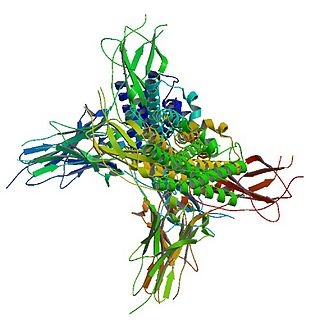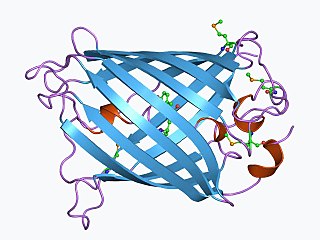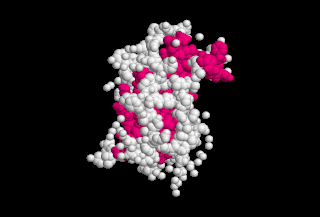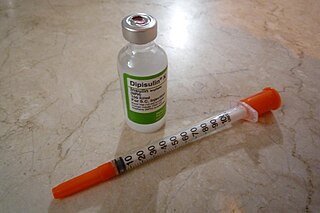 W
WDornase alfa is a highly purified solution of recombinant human deoxyribonuclease I (rhDNase), an enzyme which selectively cleaves DNA. Dornase alfa hydrolyzes the DNA present in sputum/mucus of cystic fibrosis patients and reduces viscosity in the lungs, promoting improved clearance of secretions. This protein therapeutic agent is produced in Chinese hamster ovary cells.
 W
WFactor VIII (FVIII) is an essential blood-clotting protein, also known as anti-hemophilic factor (AHF). In humans, factor VIII is encoded by the F8 gene. Defects in this gene result in hemophilia A, a recessive X-linked coagulation disorder. Factor VIII is produced in liver sinusoidal cells and endothelial cells outside the liver throughout the body. This protein circulates in the bloodstream in an inactive form, bound to another molecule called von Willebrand factor, until an injury that damages blood vessels occurs. In response to injury, coagulation factor VIII is activated and separates from von Willebrand factor. The active protein interacts with another coagulation factor called factor IX. This interaction sets off a chain of additional chemical reactions that form a blood clot.
 W
WFilgrastim, sold under the brand name Neupogen among others, is a medication used to treat low neutrophil count. Low neutrophil counts may occur with HIV/AIDS, following chemotherapy or radiation poisoning, or be of an unknown cause. It may also be used to increase white blood cells for gathering during leukapheresis. It is given either by injection into a vein or under the skin.
 W
WA FMN-binding fluorescent protein (FbFP), also known as a LOV-based fluorescent protein, is a small, oxygen-independent fluorescent protein that binds flavin mononucleotide (FMN) as a chromophore.
 W
WFollicle-stimulating hormone (FSH) is a gonadotropin, a glycoprotein polypeptide hormone. FSH is synthesized and secreted by the gonadotropic cells of the anterior pituitary gland, and regulates the development, growth, pubertal maturation, and reproductive processes of the body. FSH and luteinizing hormone (LH) work together in the reproductive system.
 W
WThe green fluorescent protein (GFP) is a protein that exhibits bright green fluorescence when exposed to light in the blue to ultraviolet range. The label GFP traditionally refers to the protein first isolated from the jellyfish Aequorea victoria and is sometimes called avGFP. However, GFPs have been found in other organisms such as copepods and lancelets.
 W
WGrowth hormone (GH) or somatotropin, also known as human growth hormones in its human form, is a peptide hormone that stimulates growth, cell reproduction, and cell regeneration in humans and other animals. It is thus important in human development. GH also stimulates production of IGF-1 and increases the concentration of glucose and free fatty acids. It is a type of mitogen which is specific only to the receptors on certain types of cells. GH is a 191-amino acid, single-chain polypeptide that is synthesized, stored and secreted by somatotropic cells within the lateral wings of the anterior pituitary gland.
 W
WHepatitis B vaccine is a vaccine that prevents hepatitis B. The first dose is recommended within 24 hours of birth with either two or three more doses given after that. This includes those with poor immune function such as from HIV/AIDS and those born premature. It is also recommended that health-care workers be vaccinated. In healthy people routine immunization results in more than 95% of people being protected.
 W
WInsulin is a peptide hormone produced by beta cells of the pancreatic islets; it is considered to be the main anabolic hormone of the body. It regulates the metabolism of carbohydrates, fats and protein by promoting the absorption of glucose from the blood into liver, fat and skeletal muscle cells. In these tissues the absorbed glucose is converted into either glycogen via glycogenesis or fats (triglycerides) via lipogenesis, or, in the case of the liver, into both. Glucose production and secretion by the liver is strongly inhibited by high concentrations of insulin in the blood. Circulating insulin also affects the synthesis of proteins in a wide variety of tissues. It is therefore an anabolic hormone, promoting the conversion of small molecules in the blood into large molecules inside the cells. Low insulin levels in the blood have the opposite effect by promoting widespread catabolism, especially of reserve body fat.
 W
WInsulin aspart, sold under the brand name Novolog among others, is a type of manufactured insulin used to treat type 1 and type 2 diabetes. Typically it is taken just before eating. It is generally used by injection under the skin but may also be used by injection into a vein. Maximum effect occurs after about 1–3 hours and lasts for 3–5 hours. Generally a longer-acting insulin like NPH is also needed.
 W
WInsulin degludec (INN/USAN) is an ultralong-acting basal insulin analogue that was developed by Novo Nordisk under the brand name Tresiba. It is administered via subcutaneous injection once daily to help control the blood sugar level of those with diabetes. It has a duration of action that lasts up to 42 hours, making it a once-daily basal insulin, that is one that provides a base insulin level, as opposed to the fast- and short-acting bolus insulins.
 W
WInsulin glargine, marketed under the names Lantus among others, is a long-acting insulin, used in the management of type I and type II diabetes. It is typically the recommended long acting insulin in the United Kingdom. It is used once a day as an injection just under the skin. Effects generally begin an hour after use.
 W
WInsulin lispro, sold under the brand name Humalog among others, is a type of insulin used to treat type 1 and type 2 diabetes. Typically it is taken around the time of eating. It is used by injection under the skin or within an insulin pump. Onset of effects typically occurs within 30 minutes and lasts about 5 hours. Often a longer acting insulin like NPH is also needed.
 W
WNeutral Protamine Hagedorn (NPH) insulin, also known as isophane insulin, is an intermediate-acting insulin given to help control blood sugar levels in people with diabetes. It is used by injection under the skin once to twice a day. Onset of effects is typically in 90 minutes and they last for 24 hours. Versions are available that come premixed with a short-acting insulin, such as regular insulin.
 W
WOlamkicept, also known as soluble gp130Fc or sgp130Fc is an immunosuppressive drug candidate, which selectively blocks activities of the cytokine Interleukin-6, which are mediated by the soluble Interleukin-6. Interleukin-6 is a cytokine, which plays a dominant role in the regulation of the immune response and also in autoimmunity. Furthermore, Interleukin-6 has been demonstrated to be involved in the regulation of metabolism and body. Interleukin-6 also has many activities on neural. It was invented by the German biochemist Stefan Rose-John and it was further developed by the biotech company Conaris, which gave an exclusive world-wide license to the Swiss-based biopharmaceutical company. In December 2016, Ferring and the biotech company I-MAB signed a licensing agreement granting I-MAB exclusive rights in Asia to Olamkicept for the treatment of autoimmune disease.
 W
WPegvaliase, sold under the brand name Palynziq, is a medication for the treatment of the genetic disease phenylketonuria. Chemically, it is a pegylated derivative of the enzyme phenylalanine ammonia-lyase that metabolizes phenylalanine to reduce its blood levels.
 W
WPramlintide is an injectable amylin analogue drug for diabetes, developed by Amylin Pharmaceuticals. Pramlintide is sold as an acetate salt.
 W
WTesamorelin (INN) is a synthetic form of growth-hormone-releasing hormone (GHRH) which is used in the treatment of HIV-associated lipodystrophy, approved initially in 2010. It is produced and developed by Theratechnologies, Inc. of Canada. The drug is a synthetic peptide consisting of all 44 amino acids of human GHRH with the addition of a trans-3-hexenoic acid group.